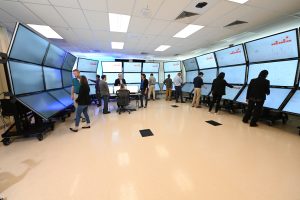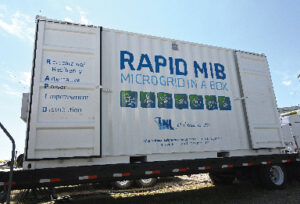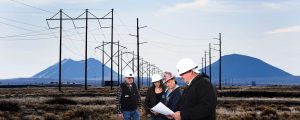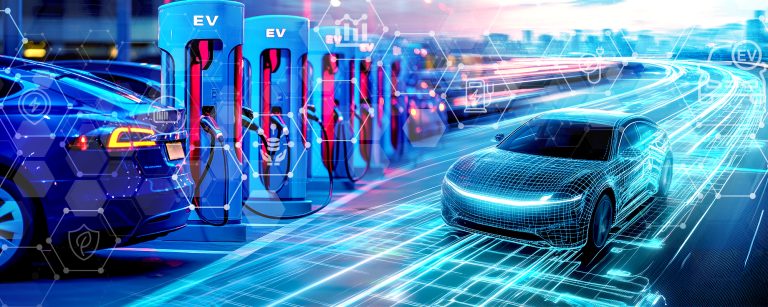Distributed Energy and Grid Systems Integration
Making Energy Move
Idaho National Laboratory’s Distributed Energy and Grid Systems Integration research program is working to reshape the global energy landscape by revolutionizing the way we understand, harness and integrate energy systems. Focusing on four pivotal areas — modeling and simulation, microgrid testing and demonstration, electric vehicles, and industrial scale solutions — INL is redefining how energy is generated, distributed and used.
Benefits of Distributed Energy and Grid Systems Integration research
- Innovation: Innovation: Access to cutting-edge research and technologies that push the boundaries of energy integration.
- Resilience: Solutions designed to withstand disruptions and enhance reliability in energy systems.
- Efficiency: Optimized systems that maximize energy output while minimizing waste and costs.
Key Capabilities
Microgrid and Simulation

New technologies, methodologies or devices designed to ensure reliable and economical operation of the electrical power grid, must be simulated and validated before being deployed. Idaho National Laboratory possesses advanced modeling capabilities that can co-simulate electrical, thermal and mechanical systems, incorporating real-world data, hardware and software into real-time simulations. Beyond these homegrown capabilities, the lab can integrate its microgrid test beds with simulation resources at other national laboratories.
INL’s Power and Energy Real-Time Laboratory (PERL) is at the forefront of innovative modeling capabilities for power grids. PERL excels in multi-domain co-simulation, integrating electrical, thermal and mechanical systems to provide a comprehensive understanding of grid behavior. This lets researchers simulate complex interactions among these systems, ensuring a more holistic analysis.
PERL’s advanced infrastructure includes Dynamic Real-Time Simulator racks configured specifically for Power-Hardware-in-the-Loop (PHIL) and Controller-Hardware-in-the-Loop (CHIL) simulations. PHIL simulations facilitate the testing and validation of control algorithms by connecting physical hardware to the simulation environment in real time. CHIL simulations enable rapid prototyping of controllers intended for real-world implementation, evaluating both algorithm and hardware performance under realistic conditions.
One of PERL’s key strengths lies in its ability to seamlessly integrate real-world data into simulations. This capability enhances the accuracy and relevance of simulations to real-world scenarios, allowing for more precise analysis and validation of new technologies and methodologies.
Moreover, PERL collaborates with other national laboratories and academic institutions to share resources and exchange knowledge. This collaborative approach enables larger-scale simulations, exemplified by the Global Real-Time Super Lab, linking resources from multiple institutions for enhanced research and development efforts in the power systems domain.
Through these advanced capabilities, PERL is driving innovation in power grid modeling, simulation and control, accelerating the development and deployment of efficient and reliable technologies essential for the future of the electrical power grid.
For more information about this work and potential partnership opportunities, please contact Ning Kang at [email protected].
Microgrid Testing & Demonstration

Today’s electrical grid was built on a model of power generation, transmission and distribution in response to user demand. The grid of the future will look far different due to continuous energy integration, more widely distributed energy resources at smaller scales, and the need for increased reliability and resilience. These systems will blur the boundaries between suppliers and consumers, resulting in two-way power flows and demand that increasingly adapts to available supply.
Microgrids, the backbone of this future, are power distribution systems equipped with distributed energy sources, storage devices and controllable loads. They can remain connected to the grid while having the ability to disconnect and function independently as self-sustaining islands when necessary. Microgrids can draw power from distributed generators, batteries or continuous resources. By combining various energy resources such as wind, concentrated or photovoltaic solar, or hydropower with the right storage options, a microgrid becomes a dynamic and controllable system, offering flexibility and manageability.
INL’s microgrid research program centers on resilience to remain operational during grid disruptions and affordability. Noteworthy successes from this initiative include the development of INL’s portable solution, the Microgrid in a Box, designed for swift deployment in emergency situations.
INL’s microgrids exhibit remarkable compatibility with diverse energy sources such as wind, solar, hydropower, and even small nuclear reactors, facilitating efficient and sustainable power generation. Moreover, these microgrids use advanced energy technologies to store energy for peak demand periods or during disruptions to the larger grid, ensuring a consistent and reliable power supply.
INL’s microgrid test bed is a comprehensive setup encompassing solar panels, energy storage devices, load banks and smart inverters. These smart inverters are critical to actively managing the flow of electricity within the microgrid. It also includes “smart home” components such as appliances and other loads that can dynamically adjust their electricity demand. The system’s load control capabilities and grid interaction algorithms allow researchers to study demand response, peak shaving and ancillary services, and to test component interactions, performance, controls and integration challenges.
This versatile system allows researchers to delve into demand response mechanisms, peak shaving techniques, ancillary services and the intricate integration challenges of various components. Furthermore, researchers explore the complexities of stabilizing dynamic systems featuring 50 to 75 percent average continuous energy content. The intermittent nature of energy sources, like wind, poses challenges that demand innovative solutions in dynamic storage and load-balancing options.
INL’s efforts extend beyond the lab. INL engineers are implementing these concepts at U.S. military bases worldwide, leveraging on-site electric vehicle testing and a full-scale power grid for unparalleled real-world demonstrations.
For more information about this work and potential partnership opportunities, please contact Kurt Myers at [email protected].
Electric Vehicles

By 2040, electric vehicles (EVs) will make up 46% of the global vehicle fleet, according to Bloomberg’s Electric Vehicle Outlook. As charging infrastructure becomes increasingly widespread, public and private entities need to understand how they can manage this infrastructure to meet the needs of EV drivers while avoiding high electricity costs and negative effects on the electric grid. This information is elusive because existing models can’t predict how widespread vehicle charging will impact the grid. Plus, every vehicle model draws power differently, and that doesn’t account for the effects of hot and cold weather in different parts of the country.
To help, INL experts have developed a software tool called Caldera, a library of high-fidelity EV charging models derived from data collected over the past decade. There are to simulate transportation networks, in some cases modeling traffic down to individual vehicles. Other tools provide similarly detailed models of electric grids. But until Caldera, no tools accurately modeled charging infrastructure by integrating transportation and grid systems. Caldera’s charging models accurately estimate charge power profiles, efficiency and power factors for a wide variety of vehicles and charging technologies under varying grid conditions. This capability is critical to accurately model future transportation scenarios.
The Caldera platform includes a control strategy module that accommodates a variety of approaches for managing EVs and stationary energy storage at charging stations as controllable loads on the grid. It contains novel algorithms for smart charging management of Level 2 charging. The module also includes algorithms to control power flow in extreme fast charging stations that charge at up to 350 kilowatts. With its charging model library, control strategy module, VehicleAI and InfrastructureAI, Caldera is a versatile tool for answering important questions about potential impacts of EV charging on the electric grid.
For more information about this work and potential partnership opportunities, please contact Eric Dufek at [email protected].
Industrial Scale

Industrial control systems are at the heart of the United States’ electric power grid, controlling the flow of power and regulating safety and reliability. Utilities have relied for decades on these systems to gather and communicate data and send control commands. As the grid has evolved to incorporate digital technology, new cybersecurity vulnerabilities have become more concerning to national security experts.
To support the Department of Energy (DOE) mission to ensure a secure, resilient and reliable energy delivery system, INL operates a utility-scale electric grid test bed. Located on DOE’s 890-square-mile INL site, the test bed is an operational, commercially fed system that includes seven substations, a control center, 61 miles of 138-kilovolt transmission lines and multiple distribution circuits at 15kV, 25kV and 35kV. In addition to providing power to INL’s key research facilities, the grid allows sections to be isolated and reconfigured for integrated testing and demonstrating state-of-the-art power systems, components and smart grid technologies. The test bed’s loop-fed substations, integral components within the grid’s architecture, are connected through modern supervisory control and data acquisition systems and a dedicated fiber-optic communication network.
These capabilities collectively represent a rare resource in the DOE national laboratory complex. INL’s electric grid test bed has been used to validate and demonstrate protective relay security methodologies and showcase at scale the potential impacts of specific cyber exploits on crucial grid operations, offering insight into their potential ramifications.
In 2019, DOE granted INL approval to extend its power grid transmission and distribution network, adding 16.5 miles of 138-kV transmission line and introducing new test pads dedicated to research and equipment testing. The previous transmission line that was replaced is now used exclusively for conducting full-scale test experiments involving diesel generators, transformers, gas-filled circuit breakers, switchgear, load banks, instrumentation and battery trailers. This repurposed line allows for the testing of various equipment without requiring power to be diverted from mission-critical INL activities.
For more information about this work and potential partnership opportunities, please contact Jake Gentle at [email protected].
Integrated Energy News
Camp Buehring, a United States military base nestled in northern Kuwait just 20 miles from the Iraqi border, faces a...Read More
When reviewing electric vehicles (EVs), automobile journalists usually cite a long list of superlatives — they’re quick, quiet, reliable and...Read More
Accurately forecasting how much power individual stations will demand from the electric grid is a major challenge facing the rapid...Read More





